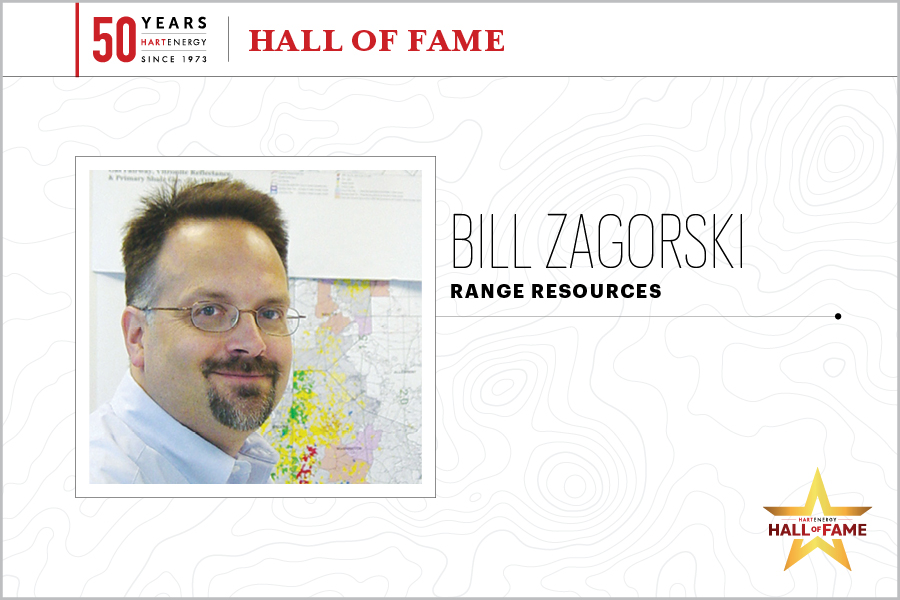Bill Zagorski
Editor's note: This profile is part of Hart Energy's 50th anniversary Hall of Fame series honoring industry pioneers of the past 50 years and the Agents of Change (ACEs) who are leading the energy sector into the future.

In 2003, geologist Bill Zagorski in Range Resources’ Appalachia office had proposed a well, Renz 1, in Washington County, Pa., that had turned out to be a dry hole. Visiting with a fellow explorer in Houston in early 2004, Zagorski looked at the rock properties of the Barnett shale. It looked just like the Marcellus shale in Pennsylvania.
He proposed to Range that Renz 1 be re-entered and completed in the Marcellus. “I was scared, you know,” Zagorski said in “The American Shales.”
“I’m the guy with the dry hole and I’m asking him for more money.”
And he asked that it be completed as Barnett wells were being completed—with a massive hydraulic frac—while the Marcellus was believed at the time to be water-sensitive.
Jeff Ventura, Range’s COO at the time who retired as CEO in 2023, was intrigued.
Zagorski said, “I would’ve expected someone to say, ‘We’ll do it, but we’ll do it next year,’ or ‘Well, we’ll try your idea but, maybe, we’ll put a small frac on it.’ Instead, Jeff was pretty adamant about getting it tested and getting it tested soon.”
Ventura said, “His geologic thinking was very counter … to what the traditional thoughts in the basin had been.”
In October 2004, the vertical Renz 1 re-entry was completed for an IP of 800 Mcf of gas. At the time, it was the largest frac job done east of the Mississippi River.
Range went on to make more vertical tests. Its first three horizontal trials made as much or less than the verticals, however. Zagorski suggested a fourth horizontal be landed in the uppermost portion of the shale.
In the meeting, he walked up with a chart. He noted that the deepest well, at about 40 feet above the bottom of the 100-foot Marcellus, made almost no gas, just 20 Mcf/d; the middle well, about 20 feet higher, came on with about 350 Mcf; the least-deep well, at about 30 feet from the top of the Marcellus, with about 600 Mcf.
Ventura said, “I remember, when he put the graph up, everybody laughed and thought, ‘Hey, that’s hilarious, Bill.’ Someone said, ‘You know, if you had two points, you could get an even straighter line.’”
But, “after brainstorming on it, we decided to try it.”
Ray Walker, a Range senior vice president at the time who is now COO of privately held Ohio shale producer Encino Energy, imported an actual rig that had been drilling for Range in the Barnett and a Barnett frac crew for the job.
Walker said, “We only had about $50 million more to make the Marcellus work.”
The horizontal, Gulla 9, came on in December 2007 with 3.2 MMcf/d—as much at the time as a good Barnett horizontal and very economic in the premium-price, northeastern U.S. gas market.
Three subsequent wells came on with 3.7 MMcf/d, 4.3 MMcf/d and 4.7 MMcf/d.
The Marcellus star was born.
Today, Appalachia produces more than 35 Bcf/d—about one-third of daily U.S. gas demand and 70% of the total U.S. gas production in 2007. It is estimated to have the potential to produce 60 Bcf/d if state and federal offices permit more pipeline takeaway.
Zagorski said horizontal development means fewer wells and 10,000 times the production. “You can have a career of 10,000 wells. I used to think all that stuff was important. I still keep all my books and records of all the things we’ve found.
“But, at the end of the day, five or six horizontal wells in the Marcellus really makes all of that obsolete. It’s incredible. Not just here; that’s in the whole U.S. oil and gas industry. It’s just amazing.
“We were—all this time—searching for [pockets of] nickels and dimes and we’re sitting here with $100 bills.”
—Nissa Darbonne, Executive Editor-at-Large
